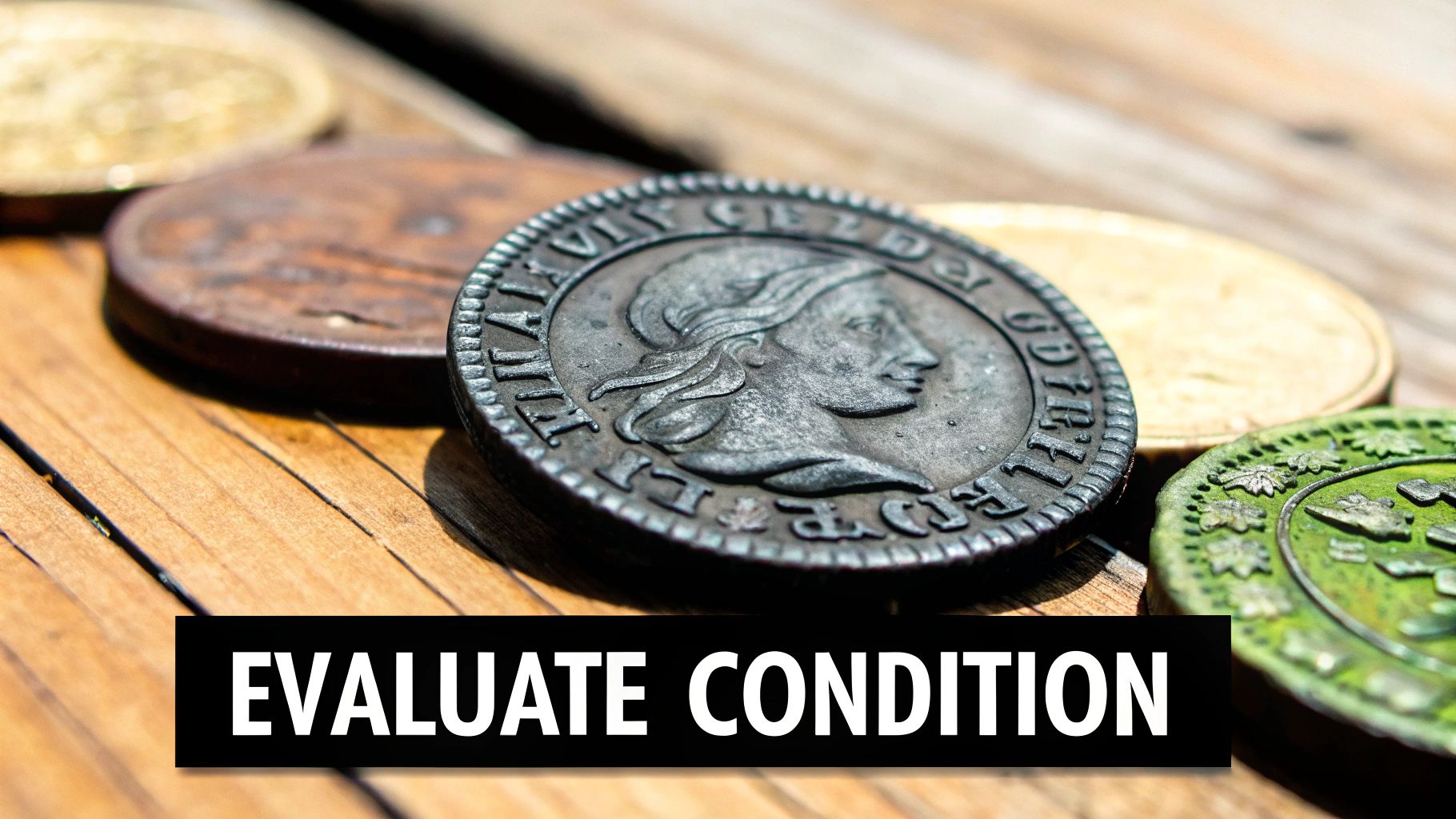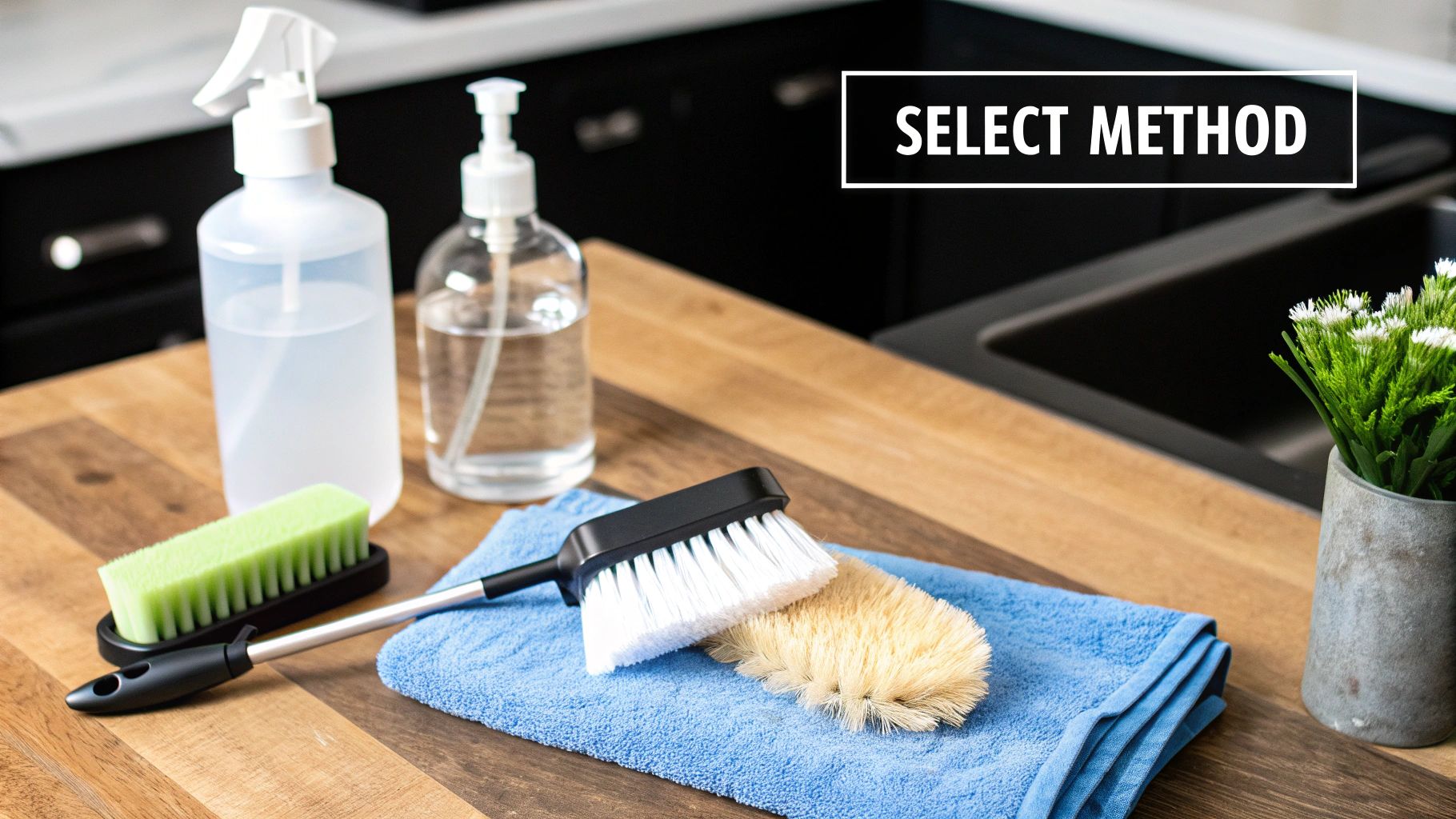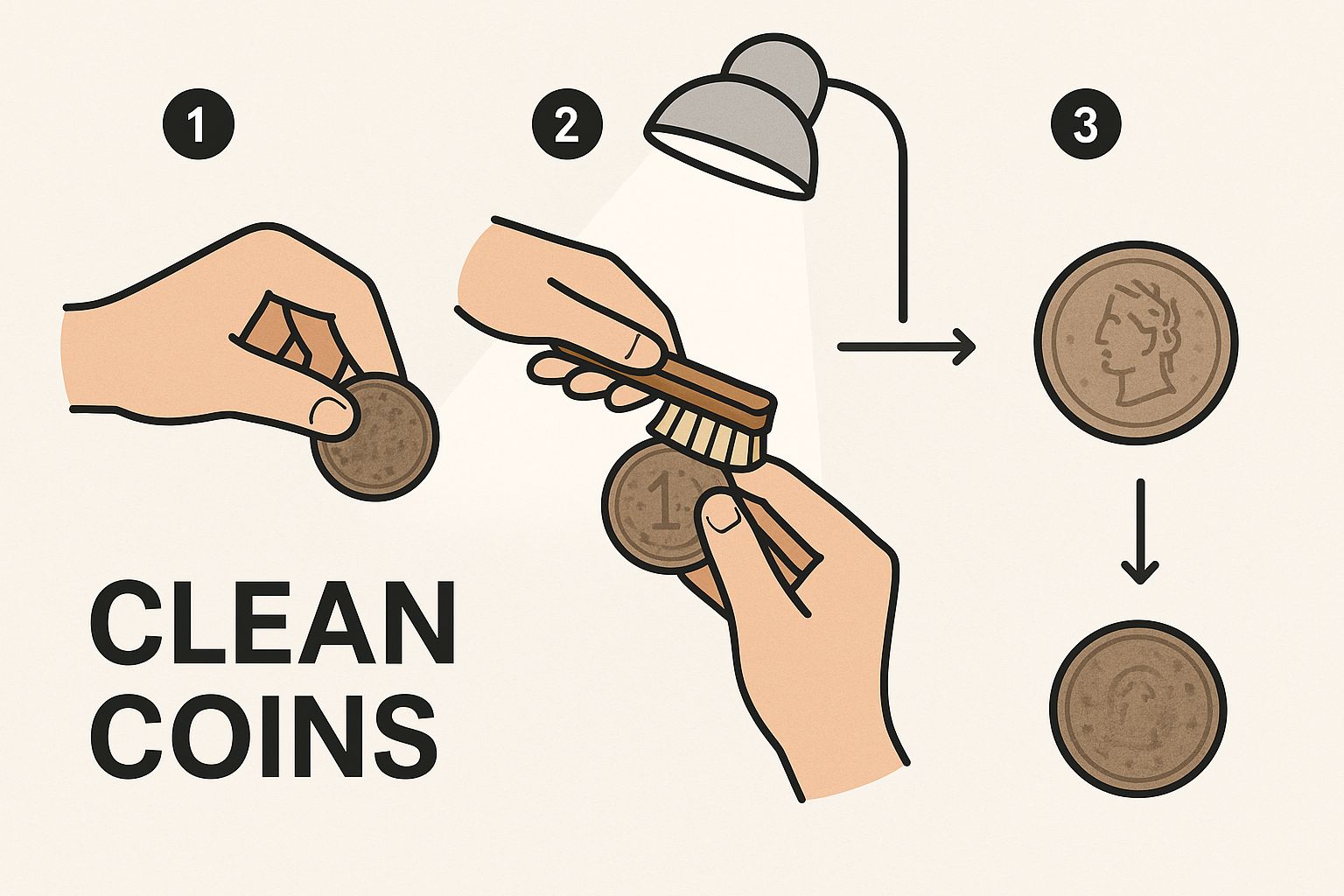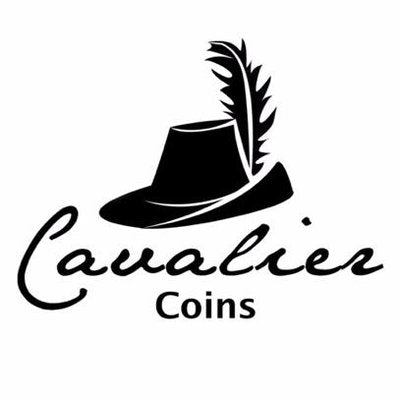Understanding The Real Value And Hidden Risks

Cleaning old coins can feel like discovering buried treasure. However, it's a delicate process with potential pitfalls. Incorrect cleaning can significantly decrease a coin's value, turning a possible investment into a regrettable expense. Therefore, understanding a coin's real value, beyond its face value, is essential before any cleaning attempts.
Preservation Versus Restoration: A Delicate Balance
Many collectors want to restore their coins to a pristine, shiny condition. However, the aged look, known as patina, often contributes significantly to a coin’s value. Patina is a natural layer that forms over time, a testament to a coin's age and authenticity.
Think of it like the finish on antique furniture. Removing it might make the piece look new, but it also strips away its history and a portion of its value. A brightly colored, uncirculated coin may seem attractive, but experienced numismatists frequently place a higher value on a coin with its original patina. Learn more about buying collectible coins.
Cleaning old coins, particularly in the UK, requires careful consideration due to their historical significance. The Portable Antiquities Scheme (PAS) recorded over 55,000 Roman coins from rural sites by 2008, with later discoveries adding another 230,000 coins. Experts recommend minimal intervention for these historical artifacts, prioritizing the preservation of their natural patina. Many numismatists and collectors appreciate a coin’s aged appearance more than a polished shine. Explore this topic further.
The High Cost Of Improper Cleaning
Imagine finding a rare coin, potentially worth a small fortune, only to accidentally damage it through improper cleaning. Sadly, this is a common scenario. Harsh chemicals and abrasive tools can scratch a coin's surface, obliterating intricate details and permanently damaging the patina. The consequence? A substantial reduction in value, sometimes amounting to thousands of pounds.
When Cleaning Helps, And When It Hurts
Knowing when to clean and when to leave a coin untouched is a skill honed through experience and research. A light dusting of dirt might benefit from careful removal, while a thick layer of grime may require professional attention.
Understanding the coin's composition is also critical. Different metals react differently to cleaning solutions. A method safe for silver might be damaging to copper. The key takeaway: when in doubt, consult a professional. Professional conservators possess the expertise and tools to assess a coin's condition, determine the best cleaning method, and preserve its historical integrity. Their intervention can mean the difference between preserving a valuable asset and experiencing a significant loss.
Essential Tools That Won't Destroy Your Coins

So, you're ready to clean your old coins? Great! But before you grab any old cleaning supplies, let's discuss using the right tools. Cleaning coins effectively, and without damage, requires a bit of care and the correct equipment. It's not just about making them shiny; it’s about preserving their historical value.
Why The Right Tools Matter
Using the wrong tools can scratch a coin’s delicate surface, reducing its value and historical significance. Imagine using sandpaper on a beautiful antique. You might remove the finish, but you'd ruin the piece in the process. Likewise, abrasive materials can obliterate the fine details and patina of a coin. This can turn a potential treasure into a damaged piece of metal.
Essential Tools For Cleaning Old Coins
Proper coin cleaning involves gentle methods and the right tools. Here’s a breakdown of what you'll need:
-
Distilled Water: Unlike tap water, distilled water is free of minerals. These minerals can leave deposits or even react with the metal. It’s the safest cleaning liquid for old coins.
-
Soft-Bristled Brushes: Avoid toothbrushes or anything with hard bristles. Opt for soft-bristled brushes designed for coin cleaning. These are gentle enough to remove dirt without scratching.
-
Cotton Swabs: Cotton swabs are great for delicate cleaning. They offer precision and control, especially around intricate details that brushes might miss.
-
Microfiber Cloths: These lint-free cloths are perfect for drying and polishing your coins gently. They won't cause scratches like paper towels or abrasive fabrics.
-
Coin Holders and Storage: After cleaning, store your coins properly to prevent future damage. Acid-free holders or coin flips help prevent tarnishing and scratches, preserving your collection.
To help visualize the different tools and their uses, we've put together a comparison table.
Before we dive in, here's a handy table summarizing essential coin cleaning tools. This comparison will help you understand the safety level, best uses, and cost of each tool.
| Tool Type | Safety Level | Best For | Cost Range | Professional Use |
|---|---|---|---|---|
| Distilled Water | Highest | All coin types | Low | Yes |
| Soft-Bristled Brushes | Medium (depending on bristle stiffness) | Removing dirt and grime | Low to Medium | Yes |
| Cotton Swabs | High | Detailed cleaning, intricate areas | Low | Yes |
| Microfiber Cloths | High | Drying and polishing | Low | Yes |
| Ultrasonic Cleaners | Medium (requires careful use) | Deep cleaning, removing stubborn deposits | High | Yes |
As you can see, some tools are suitable for all coin types and skill levels, while others are best reserved for experienced collectors or professionals. Always prioritize the safety of your coins when choosing and using cleaning tools.
Building Your Coin Cleaning Kit: Options For Every Budget
Whether you’re starting or have a seasoned collection, building a coin cleaning kit can be tailored to your budget:
-
Basic Starter Kit: Distilled water, a soft-bristled brush, and microfiber cloths are a perfect starting point.
-
Intermediate Kit: Add cotton swabs and a magnifying glass for closer inspection and more detailed work.
-
Advanced Kit: For deeper cleaning and preservation, consider specialized cleaning solutions and ultrasonic cleaners. Always research and understand the potential risks before using these more advanced techniques.
By choosing the right tools, you're taking the first step towards preserving the history and value of your coins. These straightforward tools will help you clean your coins safely and effectively, making sure they remain treasured for years to come.
Step-By-Step Methods For Every Coin Type

This infographic illustrates the delicate process of cleaning old coins. It emphasizes using a soft brush under proper lighting. The image underscores the importance of a gentle touch and a controlled environment for these often fragile items. Good lighting and the right brush are essential for assessing a coin's condition and preventing damage during cleaning.
This section outlines safe and effective cleaning methods tailored to different coin compositions. We'll focus on preserving their historical significance and potential value. Remember, patience is key throughout this process.
Cleaning Copper Coins
Copper coins, particularly older ones, frequently develop a green verdigris. This is a natural result of oxidation. Some collectors appreciate this patina, but you may choose to remove it if it's excessive.
-
Distilled Water Soak: Submerge the coin in distilled water for up to 24 hours. This helps loosen surface dirt and soften the verdigris.
-
Soft Brushing: Gently brush the coin with a soft-bristled brush. Avoid applying too much pressure, as this can scratch the delicate surface.
-
Baking Soda Paste (Optional): For stubborn verdigris, make a paste of baking soda and distilled water. Apply it carefully and let it sit for a few minutes before rinsing thoroughly. Use caution, as this method can be abrasive.
Check out our guide on how to clean dirty and rusty coins for a more detailed explanation.
Cleaning Silver Coins
Silver coins are susceptible to tarnish, a dulling of the surface caused by oxidation. Here's how to deal with it:
-
Distilled Water Rinse: Begin with a gentle rinse using distilled water.
-
Silver Cleaning Cloth (Optional): A silver cleaning cloth can effectively remove light tarnish. Gently rub it on the coin's surface.
-
Soapy Water (For Non-Valuable Coins): For heavily tarnished, non-valuable silver coins, a mixture of mild dish soap and distilled water can be helpful. Avoid this method for rare or valuable coins.
Cleaning Ancient Coins
Ancient coins demand extra care due to their age and fragility. They're often encrusted with centuries of dirt and debris. A minimalist approach is best for these coins.
-
Minimal Intervention: Focus on preserving the coin's current condition. Aggressive cleaning can result in irreversible damage.
-
Distilled Water Soak: A gentle soak in distilled water can loosen surface dirt without causing harm.
-
Professional Consultation: For anything more than a gentle rinse, consult a professional coin conservator. They possess the expertise to handle these delicate artifacts safely.
Knowing When to Stop
One of the most important aspects of cleaning old coins is knowing when to stop. Over-cleaning can drastically reduce a coin's value. If you're uncertain about the next step, consulting a professional is always the best course of action. They can assess the coin's condition and recommend suitable cleaning methods.
Remember, the goal isn't to make old coins look brand new. It's about carefully removing dirt and debris while maintaining their historical integrity. This approach will ensure your coins remain treasured possessions for generations to come.
When To Call The Professionals Instead
Sometimes, cleaning old coins requires more than just distilled water and a soft brush. Knowing when to step back and call in a professional conservator is crucial for preserving a coin's value and historical integrity. This involves understanding the limitations of at-home cleaning and recognizing situations that demand expert intervention.
Recognizing Your Limits
While basic cleaning methods are suitable for common coins, attempting to restore rare or historically significant pieces yourself can be disastrous. Professionals possess specialized knowledge and tools that most collectors don't. This specialized expertise can be the deciding factor between a successful restoration and an irreversible mistake.
For example, a coin with a delicate, historically significant patina could be irreparably damaged by even the gentlest amateur cleaning. Additionally, certain types of damage, like corrosion or encrustation, require specific treatments best left to experienced professionals.
Attempting these advanced procedures yourself can lead to further damage, significantly impacting the coin's value. Think of it like performing surgery—you wouldn’t attempt a complex procedure without the proper training and equipment.
The Professional Conservation Scene In The UK
The UK boasts a thriving community of professional coin conservators. These experts offer a range of services, from gentle cleaning and stabilization to complex restoration work. The broader industrial cleaning sector, which includes specialized services applicable to historical artifacts, also demonstrates a growing demand for professional care.
This sector is projected to reach £1.6 billion by 2024-25, growing at a rate of 4.6% annually. Find more detailed statistics here. This growth reflects a wider appreciation for professional expertise in preserving valuable and delicate items.
What To Expect From Professional Cleaning
Professional coin cleaning goes beyond simply removing dirt. Conservators assess the coin's composition, age, and condition to determine the most appropriate treatment. They utilize specialized techniques and equipment, often unavailable to amateur collectors, to clean and preserve coins without causing damage.
Furthermore, they can provide detailed documentation of the cleaning process, invaluable for insurance purposes and future resale.
Choosing A Reputable Conservator
When choosing a professional, look for accreditation from recognized organizations like the Institute of Conservation (ICON). A reputable conservator will provide a clear explanation of the proposed treatment, including potential risks and benefits. They will also offer a transparent pricing structure and a timeframe for the work.
It's worth noting that professional cleaning can sometimes increase a coin's value, particularly if it reveals hidden details or addresses damage that was detracting from its appearance. This investment in professional expertise can safeguard your coin's value and ensure its preservation for generations to come. By understanding when to call in the professionals, you’re taking a vital step in responsible coin collecting.
Costly Mistakes That Ruin Everything
Cleaning old coins can be a risky business. While we all want our coins to shine, some cleaning methods can cause irreversible damage, significantly impacting their value. Let's explore some common, and costly, coin cleaning mistakes.
The Dangers of Abrasive Cleaning
One of the biggest mistakes is using abrasive tools. Things like wire brushes, steel wool, or even toothbrushes with hard bristles can scratch a coin's surface, ruining fine details and permanently damaging the patina. Patina, a natural layer formed over time, often contributes significantly to a coin’s value and historical context. Removing it is like stripping the finish off an antique.
For example, imagine a rare George III sovereign. Its historical value could be substantial. However, harsh scrubbing could erase the monarch's portrait, transforming a valuable item into a scratched piece of metal. This damage is irreversible, leaving you with a coin worth far less.
The Chemical Catastrophe
Another common mistake is using harsh household cleaners. While effective for kitchen counters, these products can trigger a chemical reaction that damages a coin's metal. Bleach, for example, can discolor and corrode silver coins, causing permanent stains and reducing their value. Acidic cleaners can etch copper coins, destroying their historical appeal.
Think of pouring vinegar on a copper penny. The acid reacts with the copper, dulling and discoloring it. This reaction, though interesting scientifically, is disastrous for a valuable coin.
The Problem With Over-Cleaning
Even with gentle methods like distilled water and soft cloths, over-cleaning can be harmful. The urge to keep rubbing until a coin is “perfect” can thin the metal, erase details, and disrupt the natural patina. Over-cleaning is often worse than leaving a coin as is, especially for valuable or rare coins. A slightly dirty coin might retain its value, while an over-cleaned one could be permanently damaged.
The following table summarizes some safe and dangerous cleaning methods:
| Method | Safety Rating | Appropriate Use | Potential Damage | Reversibility |
|---|---|---|---|---|
| Distilled Water Rinse | High | Most coins | Minimal | Usually |
| Soft-Bristled Brush (gentle) | Medium | Removing loose dirt | Scratches if too harsh | Sometimes |
| Baking Soda Paste | Low | Stubborn dirt (non-valuable coins) | Abrasion, patina removal | Rarely |
| Wire Brush | Very Low | Never | Severe scratches, patina removal | Never |
| Household Cleaners | Very Low | Never | Chemical damage, discoloration | Never |
This table provides a clear comparison of various coin cleaning methods, highlighting the potential risks associated with each technique. It emphasizes the importance of choosing the right approach to preserve a coin's value and historical integrity.
The Psychology of Cleaning
The desire for a “perfect” coin often leads to these costly errors. Collectors sometimes focus so intently on removing every speck of dirt that they forget the bigger picture: preserving the coin's historical integrity. This urge to keep cleaning, while understandable, distinguishes successful collectors from those with boxes of damaged coins. Learning restraint and appreciating the natural beauty of aged coins is essential. Knowing when to stop is as important as knowing how to clean.
Recognizing previously damaged coins is also key when buying. Look for signs like unnatural shine, scratches cutting through the patina, or inconsistencies in the surface texture. These can indicate previous cleaning, suggesting a potential decrease in value. By understanding these costly mistakes and recognizing their signs, you can protect your investment and ensure your collection retains its value and historical significance.
Protecting Your Investment After Cleaning
Cleaning your old coins is only half the journey. Preserving their condition afterward is just as important, especially if you want to maintain or even increase their value. This means proper drying, handling, and storage are key. You might be interested in: The Most Valuable Coins in the World.
Drying Techniques That Prevent Damage
After cleaning, proper drying is paramount. Leaving moisture can lead to water spots, tarnishing, or even corrosion. This is especially true for copper and silver coins, which are more prone to damage.
-
Patting Dry: Gently pat your coins dry with a soft, lint-free microfiber cloth. Avoid rubbing, which can cause micro-scratches.
-
Air Drying: Less delicate coins can air dry on a clean, absorbent surface like a soft towel. Make sure the area is dust-free.
-
Warm Air (Caution): A hairdryer on a low, cool setting can speed up drying. However, be careful, as too much heat can damage some coins.
Protective Coatings: Help or Hindrance?
Whether to use protective coatings is a topic of debate among collectors. Some coatings offer a temporary barrier against environmental factors, but they can also change a coin's appearance and potentially lower its value over time. This means applying coatings isn't generally recommended for valuable or rare coins.
For common coins, a thin layer of Renaissance Wax can sometimes offer some protection against tarnish. Always test any coating on a less valuable coin first.
Creating The Ideal Storage Environment
Proper storage is essential. It's like creating a perfect microclimate for preservation. This means controlling humidity, temperature, and light exposure.
-
Humidity Control: Too much humidity speeds up corrosion, while overly dry conditions can cause cracking. Aim for around 50% relative humidity. Silica gel packets can help absorb excess moisture.
-
Temperature Stability: Temperature changes can cause metal to expand and contract, potentially leading to damage. Store coins in a cool, stable environment, away from direct sunlight and heat.
-
Light Protection: Prolonged light exposure can cause fading or discoloration. Store coins in a dark or dimly lit area, and consider UV-filtering materials for display cases.
Storage Solutions: From Basic To Bespoke
The right storage depends on your budget and collection size. Options range from simple albums to elaborate, climate-controlled cabinets.
-
Coin Albums and Folders: These provide basic protection and organization for smaller collections.
-
Coin Capsules: Individual capsules offer better protection against the environment and handling.
-
Custom Cabinets: For larger collections, custom cabinets with humidity control and security features offer the best preservation.
Maintenance and Documentation
After cleaning and storing your coins, regular maintenance is essential. This includes periodic checks for signs of deterioration and replacing silica gel packets.
Detailed documentation, including photos and descriptions, helps maintain provenance and ensures proper insurance coverage. This documentation is also valuable for future resale.
Are you ready to expand your coin collection? Explore the selection at Cavalier Coins Ltd. Whether you're a seasoned numismatist or just beginning, they have something for everyone. Visit them today!

